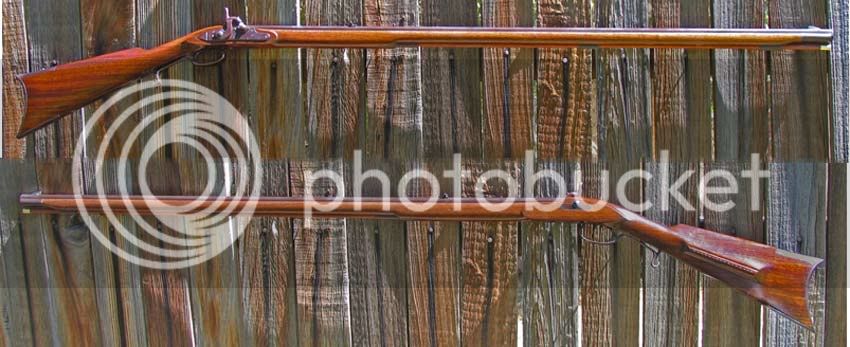-
This community needs YOUR help today. We rely 100% on Supporting Memberships to fund our efforts. With the ever increasing fees of everything, we need help. We need more Supporting Members, today. Please invest back into this community. I will ship a few decals too in addition to all the account perks you get.

Sign up here: https://www.muzzleloadingforum.com/account/upgrades -
Friends, our 2nd Amendment rights are always under attack and the NRA has been a constant for decades in helping fight that fight.
We have partnered with the NRA to offer you a discount on membership and Muzzleloading Forum gets a small percentage too of each membership, so you are supporting both the NRA and us.
Use this link to sign up please; https://membership.nra.org/recruiters/join/XR045103
You are using an out of date browser. It may not display this or other websites correctly.
You should upgrade or use an alternative browser.
You should upgrade or use an alternative browser.
bean rifle
- Thread starter welafong1
- Start date

Help Support Muzzleloading Forum:
This site may earn a commission from merchant affiliate
links, including eBay, Amazon, and others.
Oddly I don't seem to have much that is written about the Bean rifles but I know there several "Bean's" who were gunmakers.
There was a Baxter, a James and a Russell Bean in East Tennessee and the Bean rifle is typified by what we commonly call a "Tennessee Rifle".
They built these muzzleloading rifles in the 1870's.
The rest of this is based on my memory of the things I've read about these guns while researching the Tennessee prior to my building one of them.
IMO, the Tennessee Rifle is typically a slender fullstock, iron mounted percussion rifle of .45 caliber or smaller. They were usually plain uncarved rifles without inlays.
Walnut was a common stock wood.
The trigger plates are long and the barrel tangs on these rifles are very long, often extending the full length of the wrist and on occasion extending up to the comb of the stock and some distance down it towards the butt plate.
The barrel tangs often have multiple screws extending down thru the wrist into the trigger plate which greatly strengthens the slender wrist.
The trigger guard is often forged wrought iron with a full or partial curl at the rear of the slender rail behind the trigger loop.
The Butt plate was often sheet stock hammer welded or brazed where the rear face meets the upper tang.
The barrels were straight octagons in form.
The percussion rifles made in Tennessee almost always have a lock with a rounded rear on the lockplate unlike the more pointed German style locks that I used on my Tennessee.
My version of a Tennessee (with an incorrect lock that I wanted to salvage from another build) built with a Pecatonica River pre-carved stock.

There was a Baxter, a James and a Russell Bean in East Tennessee and the Bean rifle is typified by what we commonly call a "Tennessee Rifle".
They built these muzzleloading rifles in the 1870's.
The rest of this is based on my memory of the things I've read about these guns while researching the Tennessee prior to my building one of them.
IMO, the Tennessee Rifle is typically a slender fullstock, iron mounted percussion rifle of .45 caliber or smaller. They were usually plain uncarved rifles without inlays.
Walnut was a common stock wood.
The trigger plates are long and the barrel tangs on these rifles are very long, often extending the full length of the wrist and on occasion extending up to the comb of the stock and some distance down it towards the butt plate.
The barrel tangs often have multiple screws extending down thru the wrist into the trigger plate which greatly strengthens the slender wrist.
The trigger guard is often forged wrought iron with a full or partial curl at the rear of the slender rail behind the trigger loop.
The Butt plate was often sheet stock hammer welded or brazed where the rear face meets the upper tang.
The barrels were straight octagons in form.
The percussion rifles made in Tennessee almost always have a lock with a rounded rear on the lockplate unlike the more pointed German style locks that I used on my Tennessee.
My version of a Tennessee (with an incorrect lock that I wanted to salvage from another build) built with a Pecatonica River pre-carved stock.

It is Foxfire 5. Here are picture from the book of an original Bean rifle of 1831. Characteristics listed as typical of Bean rifles, among others:
1) distinctive side plate
2) trigger guard with a circle at the rear end
3) 2-piece banana patchbox hinged in the middle
4) extended tang which runs up over the comb, on some all the way to the buttplate
5) sharp point at the toe of the buttplate
6) metal plate as a return of the toe of the buttplate
7) extended ramrod entry pipe


Spence
1) distinctive side plate
2) trigger guard with a circle at the rear end
3) 2-piece banana patchbox hinged in the middle
4) extended tang which runs up over the comb, on some all the way to the buttplate
5) sharp point at the toe of the buttplate
6) metal plate as a return of the toe of the buttplate
7) extended ramrod entry pipe


Spence
Capt. Jas.
58 Cal.
- Joined
- Aug 19, 2005
- Messages
- 3,005
- Reaction score
- 1,249
Here is a copy of an original Bean from a private collection in the Valley of VA. Stock/hardware measurements and details carefully copied.
http://contemporarymakers.blogspot.com/2011/01/jim-hash.html
http://contemporarymakers.blogspot.com/2011/01/jim-hash.html
Last edited by a moderator:
Similar threads
- Replies
- 2
- Views
- 173
- Replies
- 1
- Views
- 656
Latest posts
-
FOR SALE Custom made 36cal full stock percussion- squirrel rifle
- Latest: Johnny Too-Tall
-
-
-
-
-
-
-
-




